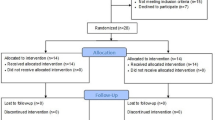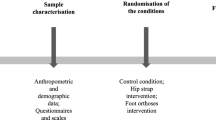Abstract
Purpose
The aim of this study was to investigate the effects of foot core training (FCT) on dynamic function and balance, in addition to exercises for strengthening and stretching of hip and knee muscles in females with patellofemoral pain (PFP).
Methods
Twenty-eight females with PFP were randomized into foot core training (FCT, n = 13) and standardized exercise groups (EXE, n = 15). The Timed-Up&Go Test (TUG) was used for dynamic function and balance, and Y-Balance Test (YBT) was used for dynamic balance; performed at baseline and after 6 weeks of the exercise program. For the EXE exercise program, routine and widely used exercises for strengthening and stretching of hip and knee muscles were selected. For patients assigned to the FCT, a similar program was performed with the addition of FCT. Physiotherapist-supervised exercise sessions were scheduled 2 times per week for 6 weeks and performed as a home program on the other days of the week.
Results
Both groups displayed decreases in TUG scores, whereas YBT scores increased in both groups. No significant group by time interaction and no between-group differences were found (P > 0.05).
Conclusion
In conclusion, the results from this study indicate that the dynamic balance impairment is due to not only foot pronation but also the malalignment of knee biomechanics and pain in PFP patients. We believe that there may be a need for a longer training period to achieve improvements in PFP patients.
Trail Registration
clinicaltrials.gov NCT03099512.

Similar content being viewed by others
Data availability
Data sharing not applicable – no new data generated, or the article describes entirely theoretical research : Data sharing not applicable to this article as no datasets were generated or analysed during the current study.
Abbreviations
- PFP:
-
Patellofemoral pain
- FC:
-
Foot core
- SFE:
-
Short Foot Exercises
- VAS:
-
The Visual Analogue Scale
- FCT:
-
Foot Core Training Group
- EXE:
-
Standardized Exercise Group
- TUG:
-
The Timed-Up&Go Test
- YBT:
-
The Y-Balance Test
- ant:
-
Anterior
- PL:
-
Posterolateral
- PM:
-
Posteromedial
- ANOVA:
-
A two-way (group by time) mixed-model analysis of variance
- ηp 2 :
-
Partial eta-squared
References
Smith BE et al (2018) Incidence and prevalence of patellofemoral pain: a systematic review and meta-analysis. PLoS ONE 13(1):e0190892
Powers CM et al (2012) Patellofemoral pain: proximal, distal, and local factors, 2nd international research retreat. J Orthop Sports Phys Ther 42(6):A1-54
Arun B, Vakkachan T, Abraham B (2013) Comparison of dynamic postural control with and without patellofemoral pain syndrome using star excursion balance test. J Med Sci Technol 2:1–6
Mahmoud WSE-d, Kamel EM (2015) The effect of additional balance training program to gluteus medius strengthening exercises on patellofemoral pain syndrome. Int J Ther Rehabil Res 4(2):7
de Moura Campos Carvalho ESAP et al (2016) Dynamic postural stability and muscle strength in patellofemoral pain: is there a correlation? Knee 23(4):616–621
de Vasconcelos GS et al (2021) Adding muscle power exercises to a strength training program for people with patellofemoral pain: protocol of a randomized controlled trial. Trials 22(1):1–11
Nedelkou A et al (2021) Does somatosensory feedback from the plantar foot sole contribute to verticality perception? Somatosens Mot Res 38(3):214–222
Cobb SC et al (2014) The relationship among foot posture, core and lower extremity muscle function, and postural stability. J Athl Train 49(2):173–180
Shrader JA et al (2005) Navicular drop measurement in people with rheumatoid arthritis: interrater and intrarater reliability. Phys Ther 85(7):656–664
Panjabi MM (1992) The stabilizing system of the spine. Part I. Function, dysfunction, adaptation, and enhancement. J Spinal Disord 5:383–383
McKeon PO et al (2015) The foot core system: a new paradigm for understanding intrinsic foot muscle function. Br J Sports Med 49(5):290–290
Mulligan EP, Cook PG (2013) Effect of plantar intrinsic muscle training on medial longitudinal arch morphology and dynamic function. Man Ther 18(5):425–430
Lynn SK, Padilla RA, Tsang KK (2012) Differences in static-and dynamic-balance task performance after 4 weeks of intrinsic-foot-muscle training: the short-foot exercise versus the towel-curl exercise. J Sport Rehabil 21(4):327–333
Moon DC, Kim K, Lee SK (2014) Immediate effect of short-foot exercise on dynamic balance of subjects with excessively pronated feet. J Phys Ther Sci 26(1):117–119
Lee E, Cho J, Lee S (2019) Short-foot exercise promotes quantitative somatosensory function in ankle instability: a randomized controlled trial. Med Sci Monit 25:618
Janda V, VaVrova M (1996) Sensory motor stimulation. In: Liebenson C (ed) Rahabilitation of the spine. Williams&Wilkins, Baltimore, pp 319–328
Crossley KM et al (2016) 2016 Patellofemoral pain consensus statement from the 4th International Patellofemoral Pain Research Retreat, Manchester. Part 1: terminology, definitions, clinical examination, natural history, patellofemoral osteoarthritis and patient-reported outcome measures. Br J Sports Med 50(14):839–843
Collins N et al (2008) Foot orthoses and physiotherapy in the treatment of patellofemoral pain syndrome: randomised clinical trial. BMJ 337:a1735
Boonstra AM et al (2014) Cut-off points for mild, moderate, and severe pain on the visual analogue scale for pain in patients with chronic musculoskeletal pain. Pain 155(12):2545–2550
Selfe J et al (2013) Targeted interventions for patellofemoral pain syndrome (TIPPS): classification of clinical subgroups. BMJ Open 3(9):e003795
Podsiadlo D, Richardson S (1991) The timed “Up & Go”: a test of basic functional mobility for frail elderly persons. J Am Geriatr Soc 39(2):142–148
Bohannon RW (2006) Reference values for the timed up and go test: a descriptive meta-analysis. J Geriatr Phys Ther 29(2):64–68
Hoglund LT et al (2015) Physical performance measurement in persons with patellofemoral osteoarthritis: a pilot study. J Back Musculoskelet Rehabil 28(2):335–342
Chimera NJ, Smith CA, Warren M (2015) Injury history, sex, and performance on the functional movement screen and Y balance test. J Athl Train 50(5):475–485
Crossley KM et al (2016) 2016 Patellofemoral pain consensus statement from the 4th International Patellofemoral Pain Research Retreat, Manchester. Part 2: recommended physical interventions (exercise, taping, bracing, foot orthoses and combined interventions). Br J Sports Med 50(14):844–852
Peters JS, Tyson NL (2013) Proximal exercises are effective in treating patellofemoral pain syndrome: a systematic review. Int J Sports Phys Ther 8(5):689–700
Mascal CL, Landel R, Powers C (2003) Management of patellofemoral pain targeting hip, pelvis, and trunk muscle function: 2 case reports. J Orthop Sports Phys Ther 33(11):647–660
Myer GD et al (2015) High knee abduction moments are common risk factors for patellofemoral pain (PFP) and anterior cruciate ligament (ACL) injury in girls: is PFP itself a predictor for subsequent ACL injury? Br J Sports Med 49(2):118–122
Menz HB, Morris ME, Lord SR (2005) Foot and ankle characteristics associated with impaired balance and functional ability in older people. J Gerontol A Biol Sci Med Sci 60(12):1546–1552
Newsham KR (2010) Strengthening the intrinsic foot muscles. Int J Athl Ther Train 15(1):32–35
Acknowledgements
This study was supported by the Hacettepe University Scientific Research Project Coordination Unit (HUBAP) (TDK-2017-14658). Except these, there was no other financial support or other benefits from commercial sources for this study.
Author information
Authors and Affiliations
Contributions
Conceptualization: PK, AAK, NB. Methodology: PK, VBT, NB. Formal analysis and investigation: PK. Writing—original draft preparation: PK. Writing—review and editing: VBT, NB, AAK. Funding acquisition: PK, AAK. Resources: VBT. Supervision: NB, VBT.
Corresponding author
Ethics declarations
Conflict of interest
The authors declare that they have no competing interest.
Ethical approval
This study conforms to the principles outlined in the Declaration of Helsinki.
Informed consent
The Institutional Review Board approved the study and written informed consent was obtained from all participants.
Additional information
Publisher's Note
Springer Nature remains neutral with regard to jurisdictional claims in published maps and institutional affiliations.
Rights and permissions
About this article
Cite this article
Kısacık, P., Bayrakcı Tunay, V., Bek, N. et al. Is there any additional effect of foot core training on dynamic function and balance in women with patellofemoral pain? A randomized controlled study. Sport Sci Health 20, 137–143 (2024). https://doi.org/10.1007/s11332-023-01076-6
Received:
Accepted:
Published:
Issue Date:
DOI: https://doi.org/10.1007/s11332-023-01076-6




